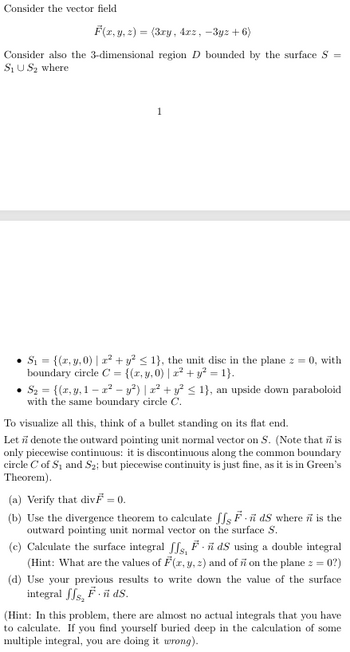
Elementary Linear Algebra (MindTap Course List)
8th Edition
ISBN: 9781305658004
Author: Ron Larson
Publisher: Cengage Learning
expand_more
expand_more
format_list_bulleted
Question

Transcribed Image Text:Consider the vector field
F(x, y, z)=(3xy, 4x2, -3yz+6)
Consider also the 3-dimensional region D bounded by the surface S
S₁US₂ where
1
=
• S₁ = {(x, y, 0) | x² + y² ≤ 1}, the unit disc in the plane z = 0, with
boundary circle C = {(x, y, 0) | x² + y² = 1}.
S₂ = {(x, y, 1x2 − y²) | x² + y² ≤ 1}, an upside down paraboloid
with the same boundary circle C.
To visualize all this, think of a bullet standing on its flat end.
Let n denote the outward pointing unit normal vector on S. (Note that ñ is
only piecewise continuous: it is discontinuous along the common boundary
circle C of S₁ and S2; but piecewise continuity is just fine, as it is in Green's
Theorem).
(a) Verify that divF = 0.
(b) Use the divergence theorem to calculate JJ FdS where n is the
outward pointing unit normal vector on the surface S.
(c) Calculate the surface integral ffs, F.ñ dS using a double integral
(Hint: What are the values of F(x, y, z) and of n on the plane z = 0?)
(d) Use your previous results to write down the value of the surface
integral f√s, F. ñ ds.
(Hint: In this problem, there are almost no actual integrals that you have
to calculate. If you find yourself buried deep in the calculation of some
multiple integral, you are doing it wrong).
Expert Solution
This question has been solved!
Explore an expertly crafted, step-by-step solution for a thorough understanding of key concepts.
Step by stepSolved in 2 steps with 2 images

Knowledge Booster
Similar questions
- Find an orthonormal basis for the subspace of Euclidean 3 space below. W={(x1,x2,x3):x1+x2+x3=0}arrow_forward2. Find a vector that is perpendicular to the surface x² + y² + z² = xyz + 8 at the point (1,2,3).arrow_forward5. Chose the curl of ƒ (x, y, z) = x²î + xyzĵ– zk at the point (2, 1, -2). a) 2î + 2k b)-2i-2j c) 4î-4j+2k d) - 2i-2karrow_forward
- 13. For the vector fields: A = x + 2y + 3z2; ŷ Check both product rule given in below: B = 3y - 2x ŷ. V(A.B) = A x (V x B) + B × (V x A) + (A · V)B + (B · V)A V. (A x B) = B. (V x A) - A. (V x B)arrow_forwardFind a vector function that represents the curve of intersection of the two surfaces. The cone y = V = v 2x2 +9z2 and the plane y = 5+3z r(t) = ( 1 t2 2' 15 6. 1 r(t) = (t, 1 t2 2' 15 6. 1 5 r(t) = (! + 구 t, 15 %3D 6. r(t) = (t, - + 2' 15 6. r(t)%3D = ( t, ť + 15 6.arrow_forwardFind a vector parallel to the plane 2x - y - z = 4 and orthogonal to i + j + karrow_forward
- Find ProjS(u) where S is the space spanned by v1= (1/3)(2,1,2) and v2= (1/3)(-2,2,1). Find the orthogonal complement, u', of u relative to S. u= (3,2,-3)arrow_forwardYour friends correctly calculate the gradient vector for f(x, y)=x+y° at the point (2,-3) as follows: Vf(2,–3)=(2x, 2y ) =(4.-6) %3D (3.-4) They say that (4,-6) is orthogonal to the surface at the point where x=2 and y=-3 (at the point (2,-3, 13)). Unfortunately, they are incorrect, and you will help them. (a) For f(x, y)=x² +y² ,what is (4,-6) orthogonal to when r=2 and y=-3? (Drawing a picture may help) %3D |arrow_forwardConsider the following vector function: A = (6xy)x+ (3x²)ŷ + (4z)2 a) Calculate the divergence and the curl of this vector function. b) Calculate the path integral of this vector function from the origin to the point (1,1,1) using two different paths: 1) going in the direction from (0,0,0) to (1,0,0), then the y direction from (1,0,0) to (1,1,0), then the 2 direction from (1,1,0) to (1,1,1) and 2) going in a straight line from (0,0,0) to (1,1,1). c) Are the results of parts a) and b) consistent with each other? Explain why or why not.arrow_forward
- If V=R\power{3}, and W\index{1} is the xy plane and let W\index{2} is yz-plane: W\index{1}={(x,y,0):x,y∈R} W\index{2}={(0,y,z):y,z∈R} then V is not the direct sum of W\index{1} and W\index{2}.arrow_forwardb) The tangent subspace Wp at p ES is the plane through O with normal vector p. Find an explicit formula in terms of a, b, c, x, y, z for the projection Tp(x) of a vector x = (x, y, z) = R³ to the tangent subspace Wp.arrow_forwardFind a vector function that represents the curve of intersection between the paraboloid 4x² + y² and the parabolic cylinder x = y² -1 . Then draw all three in GeoGebra (= 2 Z =arrow_forward
arrow_back_ios
SEE MORE QUESTIONS
arrow_forward_ios
Recommended textbooks for you
 Elementary Linear Algebra (MindTap Course List)AlgebraISBN:9781305658004Author:Ron LarsonPublisher:Cengage Learning
Elementary Linear Algebra (MindTap Course List)AlgebraISBN:9781305658004Author:Ron LarsonPublisher:Cengage Learning

Elementary Linear Algebra (MindTap Course List)
Algebra
ISBN:9781305658004
Author:Ron Larson
Publisher:Cengage Learning